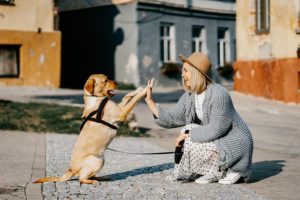Our Love Affair With Pets
 By Georgianna Donadio, PhD – In an economy that has been reeling in double-digit unemployment and unending home foreclosures, the last thing you would expect is that last year we spent a collective $50 billion on our pets. Even more surprising, this figure represents an $8 billion increase in the past three years during one of the worst U.S. economic downturns.
By Georgianna Donadio, PhD – In an economy that has been reeling in double-digit unemployment and unending home foreclosures, the last thing you would expect is that last year we spent a collective $50 billion on our pets. Even more surprising, this figure represents an $8 billion increase in the past three years during one of the worst U.S. economic downturns.
It is easy to imagine that this information must be a mistake as this represents more money now being spent on pets in the United State than the gross national product for all but 64 countries around the world. A staggering $25 billion was spent on pet healthcare and medicines. These are out-of-pocket dollars for services not covered by insurance.
Over the past five years, pets have grown in popularity; and so has the value we place on them. The 2011 American Pet Products Association survey reported that an astounding 62 percent of all American households have a pet living with them. Americans have come to view and treat their pets in human terms, providing them with designer clothes and jewelry, gourmet pet foods, corrective dental braces, and even plastic surgery.
While the pet product industry is doing a brisk business, the majority of pets today share beds or sleeping quarters in their households and are treated as beloved family members. It can even fall to the family pet to hold a family together through difficult times. The shared custody of pets after divorce is now commonplace.
But what fuels our passion to treat our animal friends as humans? What does it suggest about what may be missing in our human relationships that we are increasingly treating our animal companions often better than our extended family members or even our partners or spouses?
Two weeks ago, one of my students shared that she had given her mother a puppy for her birthday last year. The student did so because she knew her parents’ relationship was emotionally distant and that, as a result, her mother was away from the home a great deal. She hoped the puppy would keep her mother around more often, and she hoped that would help the relational rift of her parents.
At first, her mother didn’t want the pet and looked to place it elsewhere. In very short time, the pet became the center of her mother’s life. She cooked or prepared all of the dog’s meals, and she took it for acupuncture treatments every two weeks for a minor leg injury. The dog has a groomer, a trainer and a nutritionist and is currently interviewing for a doggie play group. Her mother was around the home more often, but she placed her whole focus and most of her time on caring for the pet.
What about this woman’s relationship with the husband? The student reported that her mother and father are civil to one another but there is no warmth or affection between them, unlike the unconditional and extravagant love the mother lavishes on the pet. Is it safer to love a pet rather than deal with the disappointment, conflicts and hard work of achieving a loving relationship with those closest to us?
Am I suggesting that loving our pets is wrong? Absolutely not. My family is blessed with not only a fabulous Maltese canine but also a yard full of llamas, sheep, horses and goats. Our pets are important to us. Pets enhance psychological and physical well-being. They love us, heal us and help us live longer.
Numerous studies demonstrate the healing power of pets. A Perdue University study demonstrated that when seniors face traumas or other adversity, the affection received from their pets and the bond between them help prevent depression and loneliness. Animals provide emotional support, which is an essential component for health and healing. There is a long list of health benefits from the companionship of animals.
But are we going overboard? Maybe we feel emotionally safer to love our pets or that perhaps it is less work and less vulnerable to love our pets than to develop close relationships with most of the humans we interact with on a daily basis.
Our pets love us unconditionally. They listen to us and don’t complain or express disappointment in who we are. They provide companionship without the politics or agenda of most human relationships. They accept our love and affection the way we give it; and, best of all, they happily return it. This is a wonderful thing, if it does not become a substitute for intimate human relationships. Emotional intimacy with others of our breed is critical to good health.
We are complex beings who require physical, emotional and spiritual intimacy with others. Social networking has become the way we communicate and “do” relationships. These days it is often over email and text messages that we are starting relationships or ending them, sharing major life events — even proposing marriage. The intimate contact experienced with other human beings even 10 years ago, before the dominance of the Internet and cellphones, is being replaced in large part by our pets.
To achieve balance and wholeness in our lives, we need to keep an eye on how we allow technology and the maddening pace of modern life to cut us off from one another and create fear and competition that rob us of the beauty and fulfillment of intimate and loving human relationships.
Our pets can be an essential part of the fabric of our lives. But, in the end, our challenge and our hope is to develop human relationships within which we can share, exchange, empower and enable one another to make our lives and the lives of others more rewarding and fulfilling. Download a free chapter on improving your human relationships at www.changingbehavior.org.
References:
http://www.americanpetproducts.org/press_industrytrends.asp
http://www.businessweek.com/magazine/content/07_32/b4045001.htm – The Pet Economy
http://www.vet.purdue.edu/cpb/faculty_profiles/beck_alan.html (Between Pets and People: The
Importance of Animal Companionship)
http://consensus.nih.gov/1987/1987healthbenefitspetsta003html.htm health Benefits of Pets
http://www.health.uab.edu/17813/ Karen Allen – Support effect of pets on blood pressure research.
Study published in American heart Association Scientific Sessions, 1999
